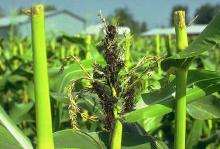Cause Sphacelotheca reiliana (Sorosporium reilianum, syn. = Ustilago reiliana), a fungus that survives as spores in soil, remaining viable at least 5 to 7 years. Spores may be wind-blown long distances. In the Willamette Valley of Oregon, corn pickers are the most likely method of spread. In the Pacific Northwest, the fungus has been observed only on corn. However, there are two strains of the fungus. One fungus attacks only corn, the other only sorghum and sudangrass. Infection reportedly occurs in the seedling stage; however, greenhouse studies demonstrate infection can occur several weeks after the corn has been planted. After infection, the fungus develops systemically. Infection may occur at soil temperatures as low as 59°F but occurs more readily at 68°F to 86°F. The fungus is not internally seedborne but can be carried on the seed surface.
Symptoms Sporulating fungal sites occur in the tassel, ear, or occasionally leaf. The gall is coarse and on eruption reveals dry spore masses with strands of vascular tissue. Dwarfing may be a dominant symptom in some varieties. Ears may be aborted or mere rudiments with leaf buds instead of the normal ear. Usually, smut spores replace the entire ear, but occasionally some ears bear a few kernels. Tassels may be infected completely or partially. Infection may be confined to individual spikelets, or it may proliferate and cause bizarre leafy structures. Smut may infect both the ear and tassel in some plants; if only the ear is infected, tassels are sterile.
Cultural control
- Rotate out of corn for 3 to 4 years if fields are only lightly infested.
- Several corn varieties-Style-pak, Commander, Rapidpak, and Reliance-have shown resistance and are useful for commercial plantings. Two other corn varieties, Goldie and Blitz, are resistant but useful only in home gardens because of other characteristics.
- Plant shallowly (1 inch) to promote rapid germination.
- Use preplant irrigation.
- Keep the seedbed moist the first 4 weeks after planting.
- After using a corn picker in an infested field, thoroughly decontaminate it before removing it from the field. The most practical method is steam cleaning. If steam-cleaning equipment is not available, wash it thoroughly with soap and water, preferably under high pressure.
- Wherever possible, plant upwind of fields known to be infested.
Chemical control Seed treatment.
- Dynasty at 0.153 fl oz/100 lb seed plus a dye. 4-hr reentry.
- Tebuzol 3.6F at 0.071 fl oz/100 lb seed plus a dye.
- Vitavax 34 at 2 to 4 oz/100 lb seed plus a dye.



